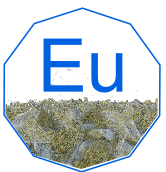Europium

Europium (Eu)
General Information
- Symbol: Eu
- Atomic Number: 63
- Atomic Weight: 151.964 u
- Element Category: Lanthanide
- Group: N/A (Lanthanides series)
- Period: 6
- Block: f-block
Physical Properties
- Appearance: Silvery-white metallic, tarnishes quickly in air
- Density: 5.264 g/cm³
- Melting Point: 822 °C (1512 °F)
- Boiling Point: 1529 °C (2784 °F)
- Phase at STP: Solid
- Electron Configuration: [Xe] 4f⁷ 6s²
- Oxidation States: +2, +3 (most common)
Chemical Properties
- Reactivity: Europium is quite reactive, oxidizing rapidly in air. It reacts with water to form europium hydroxide and with acids to form europium salts.
- Compounds: Forms compounds such as europium(III) oxide (Eu₂O₃), europium(II) chloride (EuCl₂), and europium(III) nitrate (Eu(NO₃)₃).
Uses and Applications
- Phosphors: Used in the red phosphors in television and computer screens and fluorescent lamps.
- Nuclear Reactors: Europium is used in control rods due to its high neutron absorption capacity.
- Alloys: Added to certain alloys to improve their properties.
- Lasers: Europium-doped materials are used in some types of lasers.
- Banknotes: Europium compounds are used as security features in Euro banknotes.
Occurrence and Extraction
- Natural Occurrence: Found in minerals such as monazite and bastnasite, often alongside other rare earth elements.
- Extraction: Extracted through complex processes involving the crushing of ore, magnetic separation, and solvent extraction.
Isotopes
- Stable Isotopes: Europium-151, Europium-153 (most stable)
- Radioactive Isotopes: Several radioactive isotopes, including Europium-152 (half-life of about 13.5 years) and Europium-154 (half-life of about 8.6 years).
Safety and Handling
- Hazards: Europium compounds are considered to have low toxicity, but dust and powders should be handled carefully to avoid inhalation or ingestion. Metallic europium can be a fire hazard in powder form.
- Precautions: Use appropriate protective equipment when handling europium and its compounds.
History
- Discovery: Discovered by Eugène-Anatole Demarçay in 1896.
- Name Origin: Named after the continent of Europe.
Additional Facts
- Crystal Structure: Body-centered cubic (bcc)
- Magnetic Properties: Paramagnetic
- Thermal Conductivity: 13.9 W/m·K
- Electrical Resistivity: 0.900 µΩ·m at 20°C
Summary
Europium is a versatile lanthanide with a wide range of applications in industry and technology. It is particularly valuable in phosphors for television and computer screens, nuclear reactors, and as a security feature in banknotes. Discovered in 1896, europium is named after the continent of Europe. Europium does not occur naturally in significant amounts and is typically found in minerals like monazite and bastnasite. Due to its relatively reactive nature, it requires careful handling and appropriate safety measures.
40 Question and Answer Pairs About Europium
What is the atomic number of Europium?
- 63
What is the symbol for Europium?
- Eu
What is the atomic weight of Europium?
- 151.964 u
In which group of the periodic table is Europium found?
- Lanthanides series (no specific group)
What period is Europium in?
- Period 6
What block does Europium belong to?
- f-block
What is the density of Europium?
- 5.264 g/cm³
What is the melting point of Europium?
- 822 °C (1512 °F)
What is the boiling point of Europium?
- 1529 °C (2784 °F)
What is the electron configuration of Europium?
- [Xe] 4f⁷ 6s²
What are the common oxidation states of Europium?
- +2, +3 (most common)
What is the appearance of Europium?
- Silvery-white metallic
Is Europium reactive with air?
- Yes, it oxidizes rapidly.
Name a compound of Europium.
- Europium(III) oxide (Eu₂O₃)
What is a common use of Europium in phosphors?
- Used in red phosphors for television and computer screens.
How is Europium used in the nuclear industry?
- As a neutron absorber in control rods.
What role does Europium play in alloys?
- Added to improve their properties.
How is Europium used in lasers?
- Europium-doped materials are used in some types of lasers.
What is a security application of Europium?
- Used in security features of Euro banknotes.
How is Europium typically found in nature?
- In minerals such as monazite and bastnasite.
What are the stable isotopes of Europium?
- Europium-151 and Europium-153
What safety hazard is associated with Europium dust?
- It can be a fire hazard.
Who discovered Europium?
- Eugène-Anatole Demarçay
Where does the name Europium come from?
- Named after the continent of Europe.
What is the crystal structure of Europium?
- Body-centered cubic (bcc)
Is Europium paramagnetic or diamagnetic?
- Paramagnetic
What is the thermal conductivity of Europium?
- 13.9 W/m·K
What is the electrical resistivity of Europium at 20°C?
- 0.900 µΩ·m
What is the primary oxidation state of Europium in its compounds?
- +3
Is Europium found as a free element in nature?
- No, it is found in minerals.
What is the common name of Europium(II) chloride?
- EuCl₂
What is a major application of Europium in the phosphor industry?
- Red phosphors for screens and fluorescent lamps.
How does Europium benefit the nuclear industry?
- As a neutron absorber in control rods.
What is the melting point of Europium in Kelvin?
- 1095 K
What group does Europium belong to in the periodic table?
- Lanthanides series
What is the natural abundance of Europium-153?
- It is the most stable isotope.
Can Europium be used in high-temperature applications?
- No, due to its reactivity.
What is the key property that makes Europium valuable in phosphors?
- Its ability to emit red light.
How is Europium used in the chemical industry?
- Mainly in research and specialized applications.
What precautions should be taken when handling Europium?
- Use appropriate protective equipment to avoid inhalation or ingestion.






